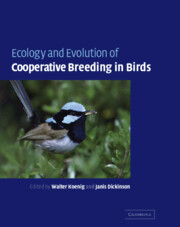Book contents
- Frontmatter
- Contents
- List of contributors
- Introduction
- 1 Evolutionary origins
- 2 Delayed dispersal
- 3 Fitness consequences of helping
- 4 Parental care, load-lightening, and costs
- 5 Mating systems and sexual conflict
- 6 Sex-ratio manipulation
- 7 Physiological ecology
- 8 Endocrinology
- 9 Incest and incest avoidance
- 10 Reproductive skew
- 11 Joint laying systems
- 12 Conservation biology
- 13 Mammals: comparisons and contrasts
- 14 Summary
- Names of bird and mammal species mentioned in the text
- References
- Taxonomic index
- Subject index
6 - Sex-ratio manipulation
Published online by Cambridge University Press: 02 December 2009
- Frontmatter
- Contents
- List of contributors
- Introduction
- 1 Evolutionary origins
- 2 Delayed dispersal
- 3 Fitness consequences of helping
- 4 Parental care, load-lightening, and costs
- 5 Mating systems and sexual conflict
- 6 Sex-ratio manipulation
- 7 Physiological ecology
- 8 Endocrinology
- 9 Incest and incest avoidance
- 10 Reproductive skew
- 11 Joint laying systems
- 12 Conservation biology
- 13 Mammals: comparisons and contrasts
- 14 Summary
- Names of bird and mammal species mentioned in the text
- References
- Taxonomic index
- Subject index
Summary
Modern evolutionary theory is based on the idea that individuals are selected for their ability to efficiently translate resources into genetic contributions to future generations. Fisher's (1930) theorem states that in sexually reproducing organisms, frequency-dependent selection should lead to an evolutionarily stable strategy of equal expenditure by parents on offspring of the two sexes. Thus, where costs of producing males and females differ, parents may be selected to invest more heavily in the cheaper sex to equalize investment ratios within a population.
Fisher's theorem assumes that the fitness effects of producing sons and daughters are the same for each parent, resulting in all parents producing the same ratio of sons and daughters. Trivers and Willard (1973) argued that where selective pressures on the two sexes vary, the reproductive value of male and female offspring may also differ. This favors individual parents that bias their broods toward the more “valuable” sex, specifically the sex that contributes more to parental fitness relative to its production cost (Trivers and Willard 1973; Charnov 1982). Such facultative biasing by individual parents can occur despite strong selection for equal investment in daughters and sons within the population. This theory contradicts Fisher's theorem because it predicts unequal allocation of resources in sons and daughters at the level of the population (Frank 1990; Pen and Weissing 2000).
Charnov (1982) discussed various theoretical reasons why individuals should vary their investment in male and female offspring.
- Type
- Chapter
- Information
- Ecology and Evolution of Cooperative Breeding in Birds , pp. 102 - 116Publisher: Cambridge University PressPrint publication year: 2004
- 14
- Cited by



